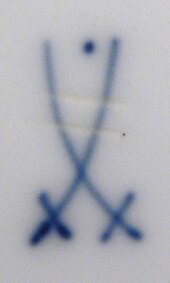Max Adolf Pfeiffer
Max Adolf Pfeiffer (* 22. June 1875 in Berlin , † 14. January 1957 in the house Falkenheim in Tutzing ) was a German mechanical engineering - engineering and manager in the ceramic industry. Under his direction, the Meissen porcelain factory experienced a special artistic boom in the 1920s.
biography
Pfeiffer was the son of a police captain and attended the Friedrich-Wilhelms-Gymnasium in Berlin from 1881 to 1888 and the Kaiser-Friedrich-Gymnasium in Frankfurt am Main from 1888 to 1895 . He then studied mechanical engineering and chemistry at the Technical University of Darmstadt (1895–1896) and at the Technical University of Braunschweig (1896–1899) from 1895 to 1899 , he completed his studies with the 1st state examination and was later given the same rank, not until 1900 award the established academic degree of graduate engineer (Dipl.-Ing.).
From 1899 to 1901 Pfeiffer initially stayed as an assistant at the Technical University of Braunschweig. In 1901 and 1902 he taught as a lecturer at the Friedrichs-Polytechnikum in Köthen (Anhalt) . In 1902 he got a job as a designer at the A. Borsig machine factory in Berlin, but in 1903 he moved to the Jacobiwerk in Meißen in the same position , which built ceramic machines and slurry mills. From 1904 to 1908 he was a construction assistant at the Technical University of Dresden , from 1908 to 1912 he was director of the Schwarzburg workshops for porcelain art in Unterweißbach (Thuringia). Since 1913 at the latest he was a member of the German Werkbund .
On April 1, 1913, Pfeiffer was appointed commercial director of the Meissen porcelain factory. In 1916, during the First World War , he succeeded in building a factory museum. From November 1, 1918, he headed the porcelain factory as general director . After the end of the war, Pfeiffer campaigned for a memorial to the fallen in Meißen, which was finally realized in the Nikolaikirche with an artistically and technically sophisticated equipment by the Meißner porcelain factory and inaugurated in 1929. Also in 1929 the first tunable and playable porcelain carillon was inaugurated in the Frauenkirche Meißen, which was made at the suggestion of Pfeiffer in the Meißen manufactory. During the years from 1924 to 1934, the sword mark was provided with an additional point at the top between the blades (so-called Pfeiffer time ). By producing based on models by Paul Scheurich , Max Esser , Gerhard Marcks , Ernst Barlach , Emil Paul Börner and other artists, he gave the Meissen porcelain manufactory an international prominence.
After the National Socialists came to power , Pfeiffer was given leave of absence on May 20, 1933 and finally dismissed on March 31, 1934. He then worked as a consultant for the Lorenz Hutschenreuther AG Selb porcelain factory . From 1938 to 1946 he was director of the Königliche Porzellan-Manufaktur Berlin . In addition, from 1941 to 1945 he headed the Karlsbad glass factory . Pfeiffer spent his twilight years at Lake Starnberg.
literature
- Georg Wenzel: German business leader . Life courses of German business personalities. A reference book on 13,000 business figures of our time. Hanseatische Verlagsanstalt, Hamburg / Berlin / Leipzig 1929, DNB 948663294 , column 1695 f.
- Otto Walcha : Meissen porcelain. From the beginning to the present. 8th edition, Verlag der Kunst, Dresden 1986, ISBN 3-364-00012-3 .
- Hermann Jedding: Meissen porcelain of the 19th and 20th centuries 1800–1933 . Keysersche Verlagsbuchhandlung, Munich 1981, ISBN 3-87405-133-1 .
- Günther Sterba: Utility porcelain from Meissen . Edition Leipzig, Leipzig 1988, ISBN 3-361-00193-5 .
- Caren Marusch-Krohn: Meissen porcelain 1918–1933. The Pfeiffer time . Edition Leipzig, Leipzig 1993, ISBN 3-361-00402-0 .
Individual evidence
- ^ List of members of the Deutscher Werkbund, as of May 1, 1913
| personal data | |
|---|---|
| SURNAME | Pfeiffer, Max Adolf |
| BRIEF DESCRIPTION | German mechanical engineer and manager in the ceramic industry |
| DATE OF BIRTH | June 22, 1875 |
| PLACE OF BIRTH | Berlin |
| DATE OF DEATH | January 14, 1957 |
| Place of death | Tutzing |
